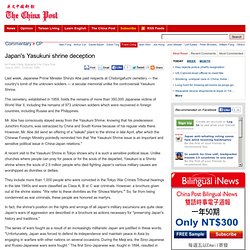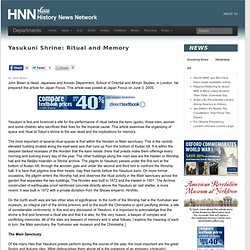

Yasukuni Shrine. CNN.com - Where war criminals are venerated - Jan. 14, 2003. Japan's controversial shrine. Yasukuni Shrine - the name means 'peaceful country' - was founded in 1869 on the orders of Emperor Meiji.

It is dedicated to the souls of about 2.5 million Japanese men, women and children who died in the name of their country since that time. They include soldiers, war-time nurses, students who entered into battle, and those who committed suicide in shame at the end of World War II. At the centre of the shrine's controversy is the fact that those venerated include 14 convicted class A war criminals, including Prime Minister General Hideki Tojo. Within the shrine, the souls of the dead are worshipped rather than just remembered. According to Japan's national Shinto religion, humans are transformed into "kami" or deities when they die, and as such are worshipped by their descendants. Surrounded by war banners and military regalia, the Yasukuni kami are venerated by hundreds of thousands of visitors who attend the shrine each year.
To the right, it is a symbol of patriotism. Heated debate. YouTube - Yasukuni Shrine Visit. Japan's Yasukuni shrine deception. The cemetery, established in 1959, holds the remains of more than 350,000 Japanese victims of World War II, including the remains of 973 unknown soldiers which were recovered in foreign countries, including Russia and the Philippines.

Mr. Abe has consciously stayed away from the Yasukuni Shrine, knowing that his predecessor, Junichiro Koizumi, was ostracized by China and South Korea because of his regular visits there. However, Mr. Abe did send an offering of a "sakaki" plant to the shrine in late April, after which the Chinese Foreign Ministry pointedly reminded him that "the Yasukuni Shrine issue is an important and sensitive political issue in China-Japan relations. " A recent visit to the Yasukuni Shrine in Tokyo shows why it is such a sensitive political issue. They include more than 1,000 people who were convicted in the Tokyo War Crimes Tribunal hearings in the late 1940s and were classified as Class A, B or C war criminals.
Yasukuni Shrine: Ritual and Memory. By John Breen John Breen is Head, Japanese and Korean Department, School of Oriental and African Studies, in London.

He prepared this article for Japan Focus. This article was posted at Japan Focus on June 3, 2005. Yasukuni is first and foremost a site for the performance of ritual before the kami (gods), those men, women and some children who sacrificed their lives for the imperial cause. This article examines the organizing of space and ritual at Tokyo's shrine to the war dead and the implications for memory. The most important of several ritual spaces is that within the Honden or Main sanctuary. On the north south axis are two other sites of significance: to the north of the Worship hall is the Yushukan war museum, an integral part of the shrine precinct, and to the south the Chinreisha or spirit pacifying shrine, a site of considerable controversy.
The Main Sanctuary The imperial connection is absolutely fundamental to an understanding of Yasukuni and the meaning of its rites.